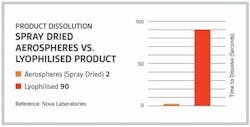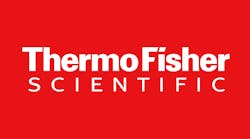It is estimated that at least 40 percent — and possibly as high as 90 percent — of new chemical entities (NCEs) are insufficiently soluble, resulting in low bioavailability and decreased efficacy, according to spray drying services provider, Upperton.1 Spray drying can be an enabling technology when it comes to bioavailability and solubility.
As particle characteristics like size and morphology can be controlled accurately, the resulting solubility and bioavailability characteristics can be influenced in a controlled manner. For example, in API manufacturing, spray drying can create stable crystalline constructs that increase API bioavailability by increasing the solubility of the active ingredient. Spray drying can be used for coating and microencapsulation of a pharma product to not only enhance bioavailability but also to create controlled- or delay-release products.
Although spray drying has been widely established in industrial manufacturing of food and chemicals, it took decades to gain acceptance in the pharmaceutical industry, says Michael Levis, Ph.D., principal scientist, particle technologies at Siegfried Ltd. “The availability of spray drying plants for pharmaceutical use — which are able to handle flammable solvents on a plant scale and comply with the cGMP requirements — were the supposition to transform spray drying from an exotic academic method to a widely applied strategy to make insoluble APIs soluble,” he says.
According to Levis, the best strategy for improving bioavailability of a poorly soluble API is to isolate it in its amorphous form via spray drying. “The amorphous material is many times more soluble than a crystalline form, thus making the product bioavailable,” he explains. “Polymers have to be added to the spray solution to avoid recrystallization during shelf life, downstream processes or application. Therefore, the best solution is to make an amorphous dispersion within a customized polymer matrix. Spray drying from organic solvents in a closed loop spray dryer promises the best success rate as it opens the widest choice for the combination of API and polymer properties.”
Combining this with competent CROs that develop solutions on a lab scale has enhanced the demand to spray dry amorphous dispersions with the goal of overcoming issues with bioavailability. According to the 2016 Nice Insight CRO Outsourcing Survey, 23 percent of respondents rely on CROs for such bioavailability services.
ASEPTIC VS. TRADITIONAL SPRAY DRYING
One type of spray drying that is gaining more attention for improving bioavailability is aseptic spray drying. Aseptic spray drying uses a hot gas to convert a liquid formulation into a dry powder suitable for parenteral applications without the need for terminal sterilization. The aseptic powder can then be filled into different presentations, such as vials. Currently, it is possible to aseptically spray dry products for up to five days continuously, manufacturing large, kilogram quantities of powder.
Efficiencies can be gained using either traditional or aseptic spray drying by co-processing APIs with solubility enhancers or stabilizers, which may not be possible with lyophilization, says Sam de Costa, stabilization project manager at Nova Laboratories. Consider the dissolution times for monoclonal antibodies (mAbs). Usually, mAbs can take a long time to dissolve, ~ 20 minutes in some instances. de Costa says this can greatly be improved by applying spray drying compared to a lyophilized product (see Figure 1). Nova’s patented aseptic spray drying technology, Aerospheres, manipulates the surface area of the powder spheres to dissolve the product instantly.
“Pharmaceutical spray drying has been well established within the pharma sector for many years, especially in the manufacture of APIs,” says de Costa. “The difference is traditional spray drying is carried out under a low bioburden manufacturing environment whereas aseptic spray drying is done under cGMP sterile conditions. This allows you to manufacture a product to injectable grade, allowing it to be used as a parenteral product.”
“From a technical point of view, there is no difference between spray drying and aseptic spray drying,” says Levis. “However, aseptic spray dryers have to be built and qualified to comply with regulations for aseptic manufacturing. For example, steam sterilization of the equipment is required and aseptic conditions must be applied and documented to avoid any microbiological contamination in the spray drying process.”
With spray drying, the pharmaceutical product is atomized into a controlled droplet size spray using an atomizer/nozzle. The droplet starts to dry rapidly within the drying chamber in contact with drying air. The resulting powder is collected within a cyclone separator. For aseptic spray drying, all of the above steps are carried out in a Grade-A manufacturing environment. Nova Laboratories uses gassed-isolator technology to achieve the Grade-A manufacturing environment. The CMO has pioneered aseptic spray drying technology and has been offering this as a service for the last eight years using what de Costa says is the world’s first cGMP, aseptic, apyrogenic spray drying facility.
Nevertheless, even standard spray dryers at Siegfried, which are used for cGMP manufacturing, are very well suited to keep the microbiologic burden of a product at a minimum, says Levis. “Our spray drying is performed within a closed system, with only minimum contact to the environment. The equipment can be effectively chemically sanitized and both inlet and outlet nitrogen are HEPA filtered. A polish filtration is a typical GMP standard; upon request, the solutions can be sterile filtered to remove any potential bacteria. In addition, secondary drying to reduce water activity and residual solvent content, combined with a reliable cooling chain for storage and transport, minimize the risk of microbiological growth on spray dried material. Any open handling is performed in a controlled environment with periodic microbiological controls.”
A MILESTONE IN ASEPTIC SPRAY DRYING
Despite the advantages of aseptic spray drying on improving bioavailability and solubility, de Costa says the pharmaceutical community has not readily adopted aseptic spray drying “because the industry is rather conservative and reluctant to apply a novel technology like aseptic spray drying as opposed to lyophilization, which is the more established method of drying.”
He points out, however, that there has been a significant shift in this mentality in recent years evidenced by the successful application of aseptic spray drying to several products. For instance, Nova Laboratories received approval from the FDA and EMA’s for Raplixa from ProFibrix BV, a wholly owned subsidiary of Mallinckrodt Pharmaceuticals. Raplixa is the world’s first aseptically spray dried biologic and is manufactured at Nova Laboratories’ sterile manufacturing facilities. Raplixa is comprised of spray-dried thrombin and spray-dried fibrinogen, which are blended and filled aseptically.3
In a press release, Karen Midthun, M.D., director of the FDA’s Center for Biologics Evaluation and Research, described the breakthrough, explaining “This approval provides surgeons with an additional option to help control bleeding during surgery when needed.” She continued,“The spray-drying process used to manufacture Raplixa produces dried powders that can be combined into a single vial. This eliminates the need to combine the fibrinogen and thrombin before use and allows the product to be stored at room temperature.”3
“Other companies exploring aseptic spray drying as a manufacturing option will see the FDA verdict as a regulatory milestone and a vote of confidence in this enabling stabilization technology,” says de Costa. “Acceptance by the regulatory authorities as a viable manufacturing method has gained attention of Big Pharma.”
Nova continues to support this product by manufacturing commercial supplies on behalf of Mallinckrodt Pharmaceuticals. He says: “This achievement in pharmaceutical manufacturing has raised a lot of interest in applying aseptic spray drying technology to a range of biologics, including monoclonal antibodies, therapeutic proteins, peptides and specialty APIs for parenteral use.”
MORE STABLE PRODUCTS
Spray drying allows pharmaceutical products to be manufactured to previously unattainable molecular characteristics, opening up opportunities for novel delivery methods. “The major benefits of spray drying — continuous processing, particle engineering ability, flowable powder and gentle drying — will enable us to create product that is versatile and stable,” says deCosta. “We expect continuing interest in the application of aseptic spray drying technology, especially for biologics. To substantiate this growing demand, Nova is currently expanding its aseptic spray drying and powder filling capabilities to support projects from proof-of-concept to commercial-scale supply within our new state-of-the-art aseptic spray drying facility.”
REFERENCES
1. Upperton, http://www.upperton.com/applications.
2. The 2016 Nice Insight Pharmaceutical Equipment Annual Survey http://www.niceinsightpharmaequipment.com/buying-trends.aspx.
3. FDA approves Raplixa to help control bleeding during surgery, April 30, 2015, http://www.fda.gov/newsevents/newsroom/pressannouncements/
ucm445247.htm.





